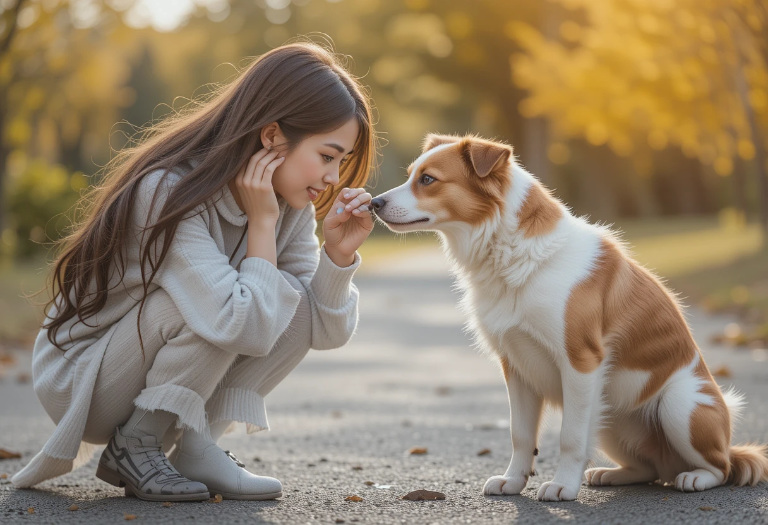
Connecting with animals is one of those gentle, slow-burning magics that doesn’t demand robes or special tools — just your presence, curiosity, and a willingness to listen. Whether you want to deepen the bond with a housecat, hear the quiet language of birds in your neighborhood, or simply open to the wild wisdom that passes through fields and parks, this is practical, accessible work. Magic here is real: it’s attention turned into relationship.
You don’t need to be an expert or have some dramatic ritual to begin. Small practices — soft breath, patient watching, tiny offerings of time — change the way animals respond. This guide pulls together simple, grounded ways to notice, respect, and gently influence animal energy so that communication becomes possible, reliable, and reciprocal. Think of it as learning a new dialect: it takes repetition, kindness, and a readiness to be wrong.
We’ll cover practical steps (how to prepare yourself, what to do when an animal is nearby), energetic approaches (centering, intention, small spells and offerings), and ethical guidelines (consent, safety, respect for wildness). There are exercises you can start tonight — short, low-risk practices that build trust and attunement. The aim: to help you connect with animals honestly, lovingly, and safely.
All magic here treats animals as sentient, autonomous beings. That means we focus on listening before asking, on consent before influence, and on reciprocity rather than control. If you keep that at the heart of your practice, you’ll find doors opening — sometimes in slow creaks, sometimes in instant, bright recognition. Let’s get into it.
Magical Ways to Connect With Animals
1. Start with Presence: Quiet is your first tool

Animals notice how you show up long before they register words. To begin practicing animal communication, start by simply being still. Sit in a place animals frequent (a window sill where birds visit, the yard where neighborhood cats pass, or your living room where your dog naps). Breathe slow, soften your face, and stop any internal script about “doing it right.” Time is the currency here — a calm, patient presence tells an animal you are not a threat.
When you’re quiet, broaden your attention beyond sight. Notice scent, temperature, small movements, and the rhythm of the environment. Hold a neutral intention like, “I am here to listen,” rather than forcing a question. This stance opens channels for subtle animal cues — a twitch of whiskers, a change in ear position, a bird’s quick flight — that become your primary language.
Practice sessions can be short: five to ten minutes a day. If you live with pets, let them approach you. Avoid reaching, sudden noises, or intense eye contact (which many animals interpret as a challenge). Over time, you’ll notice animals acting differently around you: more relaxed, more curious, more willing to be near you. That shift is the first real sign that connect with animals work is unfolding.
2. Grounding and Centering: Aligning your energy to listen

Before trying any intentional communication, ground yourself. Stand or sit with feet or hips rooted, take long slow breaths, and imagine your energy like a tree with roots going down. Centering helps you stop projecting anxious or needy thoughts — animals pick up on those instantly. When your energy is quiet and balanced, their signals come through clearer.
A simple centering exercise: place your hands lightly on your belly, breathe into the touch for six breaths, then expand your awareness outward to the space a meter around you. Repeat a soft internal phrase such as, “I am calm. I am listening.” You can also visualize a soft white or green light around you — it’s not about theatrics, it’s a gentle signaling to your own nervous system to settle.
For many people, connecting with animals is less about psychic prowess and more about emotional regulation. Animals respond best to predictability. If your energy is a steady, friendly tide, they’ll be curious instead of defensive. Add this five-minute centering to your daily routine and you’ll notice clearer, calmer interactions.
3. Learn the Body Language: Eyes, ears, tail, posture

Every species has its details, but there are universal cues. Relaxed bodies, soft eyes, loose tails (or relaxed feathers/wings) mean openness. Tense muscles, fixed stare, flattened ears, or a tail tucked between legs usually mean stress or fear. If you learn to read these signals, you can adjust your behavior to match the animal’s comfort level.
For dogs: loose wagging, mouth slightly open, play bow — these are good signs. Raised hackles, a rigid tail, or a hard stare are warnings. For cats: slow blink equals trust; flattened ears or puffed fur equals fear. For birds: ruffled feathers may be comfort or overheating (context matters), but sudden silence after song can mean alertness.
Observe before you ask. If you want to communicate with animals, begin by naming what you see: “You’re watching me but the ears are back — maybe you’re unsure.” Stating observations silently or aloud reduces projection and helps you respond in ways that increase trust.
4. Use Soft Voice and Breath: Tone matters more than words

Animals respond to pitch, rhythm, and breath more than semantic content. A soft, even voice calms; sharp, high-pitched sounds excite or alarm. Practice speaking in a low, gentle tone, and pair your words with slow exhalations. Dogs, for instance, often respond to the length and cadence of your sentences; birds will mimic tone; cats will respond to your breath near them when it’s gentle and non-threatening.
Try this: hum softly, then say a single word like “friend” or “safe” on the exhale. Make the sound steady and low. Repeat a few times, watching for changes in posture. You’re not training — you’re providing a calming pattern the animal can tune to. Over time, certain tones become associated with safety and can bridge into deeper animal communication.
5. Respect Boundaries: Consent is magical

This cannot be overstated: consent matters. Animals are not tools for your spiritual practice. If an animal steps away, hides, or tenses, accept that as a “no.” Trying to force contact harms trust and can injure or scare the animal. Ethical connection is about building mutual willingness — tiny steps toward comfort.
If you want to influence or ask for something (a behavior, a message), frame it as a question in your mind, and watch for a subtle yes/no response: approach, lean in, or a relaxed gaze can be “yes”; retreat, freeze, or a sideways glance can be “no.” Over time you’ll learn how a particular animal offers assent. Always prioritize their wellbeing over your curiosity.
6. Offerings & Small Rituals: Gifts that create good will

Animals respond to respectful, simple offerings. For domestic animals, this might be special food served slowly, or a favorite toy left near, or a soft blanket placed in a sun patch. For wild animals, offerings should be non-invasive and environmentally appropriate: scattered seeds for birds (in season, not invasive species), a safe fresh-water bowl left in a known place, or native plants that provide shelter.
Make offerings with intention rather than expectation. You might say quietly, “This is for you, with respect,” place the offering, and step back. Avoid food that’s unhealthy or harmful. Never try to habituate wild animals to human food in ways that make them dependent or put them at risk. The ritual aspect — a small phrase, a mindful placement, a bow — sends a reverent message that you are a friend, not a threat.
7. Mirrors & Mimicry: Gentle imitation as bridge-building

Mimicking an animal’s rhythm can feel intimate and helps build rapport. If a bird pauses between calls, mirror that pause with your breath. If a dog yawns in a slow, sleepy way, try a relaxed exhale and gentle stretch. For cats, the slow blink is famously reciprocal: meet a slow blink with your own and see if the cat returns it. This kind of mirroring creates a shared tempo.
Be subtle and unobtrusive. Over-mimicking or loud imitation can be confusing. The goal is to join the animal’s frequency for a moment, not to dominate their space. Mirroring is an embodied way to say, “I see you and I’m with you,” which is often enough to open tiny channels of communication.
8. Use Dreams and Meditative Journeys: Non-physical conversation

Dreamwork and meditation are traditional ways to connect with animal allies. Before sleep, place an intention: “If there is an animal who wishes to speak with me, please show me a sign.” Keep a dream journal and note any animal imagery, recurring species, colors, or feelings. Often animals will show up symbolically with clear emotional messages.
In meditation, visualize a safe clearing and invite an animal to approach on its own terms. Don’t conjure; imagine a comfortable, natural scene and watch who arrives. Ask questions within the meditation and wait for intuitive impressions — sensations, images, words, or remembered smells — that could be the animal’s response. Record everything afterward; the act of writing clarifies fuzzy impressions into usable guidance.
9. Working with Different Types: Domestic, Wild, and Feral

Each category requires a different approach. Domestic animals (pets) are used to human presence and can often form deep, ongoing bonds. With pets, you can practice scheduled sessions, teach gentle cues, and integrate magic into routine care. Use that familiarity with humility — pets also carry human stress in their bodies.
Wild animals require distance, patience, and habitat respect. Your job is to be predictable and non-threatening: leave water, plant native species, and observe quietly. If a wild animal shows curiosity, respond with stillness and non-intrusive offerings. Never attempt to handle or capture a wild animal for the sake of a spiritual practice.
Feral animals (e.g., community cats) are in-between: wary of humans yet often living near people. Work slowly, feed responsibly if you choose (research local guidelines), and build trust from a distance. For feral animals, consistent presence is more important than any single grand gesture.
10. Simple Exercises to Practice Everyday

Here are short exercises you can start with — each takes 5–15 minutes:
-
The Window Watch: Sit by a window where birds come. Count breaths, watch their patterns, and try a slow blink; note any changes.
-
The Offering Walk: Carry a small bowl of water and leave it in the same spot for three days. Observe who visits at different times and record.
-
The Slow Blink for Cats: Practice slow blinking at your cat twice daily. Reward with a soft stroke only if they lean in.
-
The Sound Play: Softly hum a tone in your yard. See which species approach or respond. Match the rhythm, then stop and listen.
-
Dream Invitation: Before sleep, write down one question for animal guidance and set the intention to receive a sign.
Do one exercise a day and keep a short journal. Patterns form faster than you expect.
11. Communication Beyond Words: Telepathy vs. Intuition

Many people expect dramatic telepathic messages; often animal communication is quieter: impressions, images, feelings, or sudden recall of a memory. Treat these intuitive nudges as data, not gospel. If you sense “hunger” for a visiting fox, for instance, check practical signs (tracks, season, visible food sources) before acting.
If you do receive clear images, test them gently: offer water or a small relevant change and watch for a reaction. Over time you’ll learn the difference between your own internal chatter and an animal’s signal. Keep a skeptical but open mind — curiosity and compassionate testing build reliable channels.
12. Healing Work and Boundaries: When to step back

Sometimes animals bring heavy emotional material, especially rescues. You might pick up on fear, grief, or past trauma. You can support with steady care, predictable routines, gentle touch, and appropriate veterinary help. However, healing should respect the animal’s pace: pushiness retraumatizes.
If an animal’s needs exceed your capacity, step back and call professionals — vets, wildlife rehabilitators, or experienced behaviorists. Your magical practice supports empathy and attunement, but it is not a substitute for medical or behavioral intervention.
13. Using Tools: Moonwater, Herbs, and Safe Perfumes (with caution)

Some practices include gentle tools: a little moon water placed near an animal’s bed (never directly in their food/water), a sprig of catnip for felines who enjoy it, or a calming tea aroma (kept safely away from ingestion). Always research safety for the species — many essential oils and herbs are toxic to animals.
If you use moon water or herbal charms, apply them with the intention of blessing space, not altering behavior. A drop on a collar charm (secure, not lickable) or a small spritz in a room corner can be a respectful way to include ritual without harming the animal. When in doubt, prioritize physical safety over symbolic intent.
14. Crafting a Daily Attunement Routine

A short daily routine cements your relationship:
-
Morning: Two minutes of centering, set an intention for animal kindness.
-
Midday: Five-minute observation session (window, yard, or pet).
-
Evening: One brief offering (soft words, a treat if appropriate, a bowed thanks).
Consistency is what builds trust. These small acts signal to animals that you are predictable, calm, and present — the exact conditions they need to approach you with curiosity rather than alarm.
15. Journal, Reflect, and Be Humble

Keep a connection journal. Record dates, weather, the animal, your emotion, and any impressions or signals. Over weeks, patterns will emerge — favorite times, particular cues, or a species that appears when you’re thinking about certain things. Journaling is magical because it trains you to notice what you used to dismiss.
Humility is your best posture. Sometimes you’ll be wrong, and that’s part of learning. Animals are not here to validate your spiritual status; they’re partners. When you get it right, the reward is simple and profound: a soft head in your lap, a bird landing on your hand, a quiet shared look. Those small miracles are the backbone of authentic animal communication.
Keeping the Connection Alive
This work asks for slow attention and steady kindness. If you commit to small daily practices, respect boundaries, and approach animals with humility, your relationships will deepen in ways that feel ordinary and miraculous at once. Keep the rituals simple, the offerings safe, and your curiosity alive.
When in doubt, choose the animal’s wellbeing over your curiosity. Let your practice be rooted in care — that’s the true magic. If you follow these steps, you’ll find that animals will meet you halfway, teaching you patience, presence, and a language that’s older than words.




